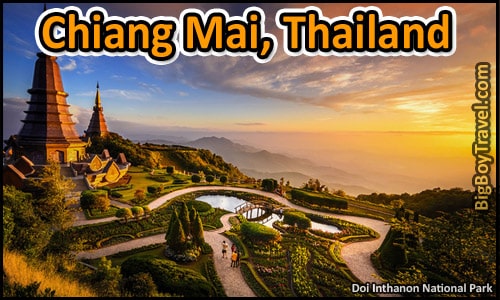Asia > Thailand > Chiang Mai Travel Guide
Chiang Mai, Thailand:
Founded In: 1296 A.D.
Suggested Stay: 3-5 Full Days
Sawadee Krap (Hello) and welcome to tantalizing Thai city of Chiang Mai! If you’ve been to the concrete urban jungle of Bangkok, you’ll quickly fall in love with the contrast of Chiang Mai’s old-world feel. Whether it’s gaggles of monks doing there daily migration for alms, finding an ancient temple around every corner, riding on elephants in the nearby jungle, babysitting tiger cubs, or relaxing in a laid-back Rasta bar, Chiang Mia has a collection of experiences you won’t find anywhere else. We hope you enjoy our in-depth Chiang Mai travel guide.
Top 10 Things To Do In Chiang Mai:
1. Visit An Elephant Camp
2. Attend The The Lantern Festival
3. Old Town Temples Walking Tour
4. Join A Monk Chat
5. Babysit Cubs at Tiger Kingdom
Read More: Top 10 Things To Do In Chiang Mai
Brief History of Chiang Mai:
Founded in 1296, Chiang Mai (New City) was built by King Mengrai as the new capital of the Lanna Kingdom when it moved from Chiang Rai. With the region under constant threat from the Mongols and Burmese, the 1 square mile core of the Chiang Mai was built with a protective moat, large wall and imposing gates. The protection of the was not enough however and the Burmese eventually overtook Chiang Mai in 1556 and held it until the Thai King drove them out in 1775. After the Burmese were driven out Chiang Mai officially joined as part of Siam, but it did take 15 years for people to move back into the city.
Chiang Mai remained relatively peaceful after it joined Siam although it was occupied by the Japanese during WWII. During the occupation, the Japanese plundered the bricks making up the city’s ancient wall to use for roads elsewhere. Up until the Japanese torn the wall down, the gates were the only way in and out of Chiang Mai and were locked from sundown to sunrise. With the Japanese long gone Chiang Mai starting rebuilding its city gates in 1975 based on photos from 1899. When finished, 5 of the 6 original gates along with all 4 corners of the original wall have been restored to what they were in 1899. Although the wall is a re-creation, many of the ancient city’s over 300 temples are still original from the 13th and 14th centuries. The unique preserved history in Chiang Mai helps to make it one of our favorite cities in the World!
Overview of Thai Architecture:
Wats or Temples typically have three common structures although the layouts great differ. The main Meeting/Ordination Hall called a Viharn or Wihan, small meeting halls for Monks called Ubosots, a ceremonial Stupa for worship called a Chedi. The Chedis are typically in the shape of a four-sided pyramid or an upside-down cone.
If a temple is building an Ubosot, you may notice a rack with 9 cannonball-sized round stones on a rack called Luk Nimits. A Luk Nimit is an important item in Buddhist temples as they are put around the edges of an Ubosot for protection. When a new temple is built eight of these stones are buried with one buried at each of the eight cardinal directions. They take the 9th Luk Nimit, decorate it with both offerings and gold leaf before placing it under a Ubosots’ main Buddha statue.







